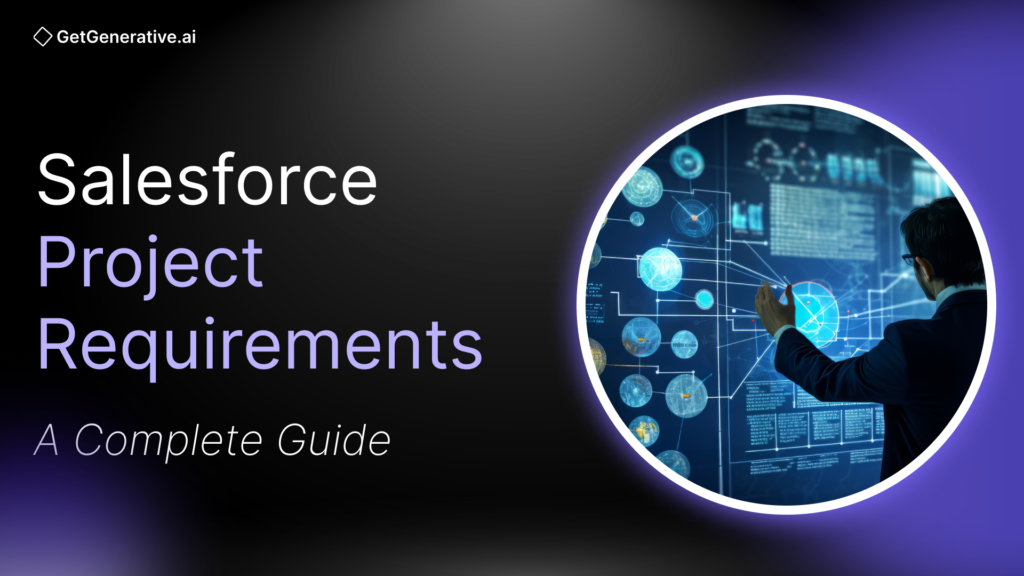Salesforce Project Requirements: A Complete Guide for 2025
Over 35% of failed projects cite poor requirements gathering as a root cause. Even more concerning, over 80% of stakeholders believe the requirements process often fails to capture actual business needs, leading to rework, missed objectives, and frustration.
These stats are not just warnings — they are wake-up calls. In the high-stakes environment of enterprise CRM transformation, requirement gathering is not a checklist — it’s a strategic imperative.
This in-depth guide explores how Salesforce leaders can master the art and science of requirement gathering. Whether you’re a seasoned Salesforce architect, an enterprise program manager, or a C-suite sponsor overseeing digital transformation, this guide offers:
- Strategic insights
- Industry-specific examples (healthcare, finance, manufacturing)
- Real-world case studies
- Best practices from 2025’s most successful Salesforce projects
With the right frameworks and foresight, your requirements process can power a Salesforce solution that delivers on time, on budget, and beyond expectations.
Let’s dive into what it takes to turn requirements into real results.
Importance of Effective Salesforce Project Requirements
Requirements serve as the critical bridge between business vision and technical execution. In a Salesforce implementation, the clarity, quality, and completeness of requirements determine whether you deliver a CRM solution that empowers or disappoints. Here are some important factors to consider:
1. Driving ROI and Business Value
Salesforce is a significant investment, and clear requirements are key to realizing its full return. A Nucleus Research study found that CRM systems deliver an average ROI of $8.71 per $1 invested — but only when properly aligned with business goals.
In a 2025 Salesforce context:
- Well-defined requirements = A well-aligned solution
- A well-aligned solution = Faster time to value
- Most companies see Salesforce ROI in under 13 months when requirements are properly scoped.
2. Ensuring Strategic Alignment Across the Enterprise
A CRM implementation must reflect broader business priorities. For example, if the corporate strategy is to enhance customer retention:
- Requirements should focus on automating follow-up sequences
- Integrating customer service interactions
- Creating unified views of account activity
According to Salesforce, lack of strategic alignment is a leading cause of CRM project failure, often resulting from teams rushing into platform configuration without clearly defining success.
Effective requirement gathering forces clarity: Why are we doing this? What metrics define success?
3. Securing Enterprise Buy-In
One of the most overlooked benefits of a rigorous requirements process is the organizational alignment it creates. Involving business users, IT, operations, and executives in requirement workshops fosters a sense of shared ownership. This directly translates into:
- Fewer change requests later
- Higher user adoption
- Lower resistance at go-live
Remember: a CRM built without user input is often a CRM nobody uses.
4. Reducing Risk and Scope Creep
Scope creep — the silent killer of projects — often originates from weak requirements. Vague statements like “Improve reporting” lead to subjective interpretations and ballooning workloads. Precise, prioritized, and signed-off requirements create a shared contract between business and delivery teams.
By clearly defining what’s in-scope, what’s out, and what’s deferred to Phase 2, you contain complexity and control costs.
Related Read – Salesforce Requirement Gathering Template
Salesforce Implementation Planning in 2025
The requirement phase doesn’t exist in isolation — it’s a foundational pillar of your broader Salesforce implementation strategy. In 2025, experienced teams understand that rigid, outdated methodologies no longer cut it.
The winning formula?
Strategic flexibility with a disciplined backbone.
Choosing the Right Methodology
The first major decision in project planning is selecting your delivery approach:
- Waterfall: Ideal for large-scale, compliance-driven initiatives (e.g., banking or pharma), where a clear blueprint must be established before development begins.
- Agile: Best for dynamic environments with evolving business needs, enabling rapid prototyping and continuous user feedback.
- Hybrid: The most popular approach in 2025. It combines structured discovery with agile delivery, giving you the best of both worlds.
Example: A global bank may start with a waterfall-style discovery phase to ensure regulatory compliance, but adopt agile sprints to build dashboards, user interfaces, or automation flows.
This hybrid flexibility allows for high-level scoping upfront while remaining responsive to mid-project changes — a common reality in Salesforce projects.
Establishing KPIs, Governance, and Clear Ownership
Without measurement and ownership, even the best-documented requirements will fail in execution. That’s why project governance must be embedded into the requirement phase:
- Set measurable KPIs during scoping:
- Improve case resolution time by 40%
- Increase lead-to-opportunity conversion by 25%
- Define roles early:
- Executive Sponsor – Aligns project with business goals
- Business Owner – Owns the problem being solved
- Salesforce Architect – Oversees solution design
- Power Users – Act as subject matter experts
Use a RACI matrix to assign ownership to requirement activities. This reduces ambiguity during scope changes and ensures stakeholder accountability.
Pro tip: Review scope control mechanisms up front. Create a lightweight but effective change management process to handle requirement shifts without causing chaos.
Aligning with Broader Business and IT Strategy
Your Salesforce implementation isn’t just a departmental tool — it’s a platform for enterprise transformation. In the planning stage:
- Involve technical teams to gather integration and data requirements
- Engage security and compliance leaders early
- Map each Salesforce capability to strategic business outcomes
For example, a requirement like “Give account managers a 360° view of customers” probably implies integrating Salesforce with ERP, customer support systems, and marketing tools.
Also consider future-readiness: AI integration, predictive analytics, and multi-cloud environments are becoming the norm, not the exception. Requirements should reflect this, even if features roll out in later phases.
IBM reports that 67% of Salesforce users are augmenting Salesforce with custom AI workflows.
Leveraging Salesforce Partners and Accelerators
In 2025, savvy enterprises don’t go it alone.
97% of enterprise Salesforce customers rely on partner support for implementations, especially around data, integrations, and regulatory compliance.
Benefits of working with Salesforce consulting partners:
- Access to industry-specific accelerators (like Manufacturing Cloud’s Sales Agreements)
- Pre-built templates and frameworks for user stories, personas, and process maps
- Expert facilitation of requirement workshops
Frameworks and User Stories
Now that the strategic and planning context is clear, let’s get tactical. How do you actually gather Salesforce requirements “like a boss” in 2025?
User Stories & Use Cases: The Language of Agile Delivery
In 2025, user stories are the standard unit of value in Salesforce projects. They help translate business needs into system functionality without jumping straight into solutions.
✅ Example User Story:
“As a support agent, I want to see a customer’s recent cases, so I can resolve issues without repetition.”
Best practice includes:
- Writing user stories collaboratively in workshops
- Linking each story to acceptance criteria
- Grouping stories into epics and themes for structure
For complex flows, consider supplementing with use cases — structured narratives that outline process steps, exceptions, and system behaviors.
Prioritization Frameworks: Managing the Backlog Smartly
You’ll always gather more requirements than you can deliver in one phase. Prioritization ensures you focus on business value first.
🔧 Popular Frameworks:
- MoSCoW Method – Must have, Should have, Could have, Won’t have
- Value vs. Effort Matrix – Helps identify “quick wins” (high value, low effort)
- Phased Roadmapping – Deliver core requirements in MVP, defer others
Tip: Keep a living, prioritized requirements backlog — especially useful if you’re working in agile sprints or iterative releases.
Also Read – Salesforce Implementation Showdown: AI vs. Traditional Methods
Pitfalls to Avoid in Salesforce Requirement Management
❌ 1. Incomplete or Vague Requirements
One of the top project killers. Ambiguous requirements like “make it user-friendly” or “improve reporting” offer zero clarity to developers or stakeholders.
Why it’s dangerous:
- Leads to assumptions during development
- Increases rework and dissatisfaction
- Creates delivery mismatches
What to do instead:
- Ensure every requirement is specific, testable, and business-driven
- Use SMART criteria: Specific, Measurable, Achievable, Relevant, Time-bound
- Ask clarifying questions: What does success look like? Who is the user? What exactly needs to improve?
According to PM360 Consulting, poor planning (including vague requirements) remains the #1 reason for project failure.
❌ 2. Lack of Executive Sponsorship and User Involvement
Projects flounder when driven solely by IT or third-party vendors, without active leadership or user feedback.
Symptoms:
- Misaligned priorities
- Weak adoption at go-live
- Missed compliance or operational needs
Fix it with:
- An engaged executive sponsor who communicates the “why” and clears roadblocks
- Diverse stakeholder involvement during requirement workshops
- Power users embedded in the project team to bridge the business-tech gap
❌ 3. Over-Customization and Scope Creep
Salesforce can be customized endlessly — and that’s the danger. Projects often spiral because of:
- Stakeholders requesting “just one more feature”
- Duplicating functionality that already exists natively
- Losing sight of the MVP
Best practices to stay disciplined:
- Map every requirement to business value
- Leverage standard Salesforce capabilities first (Flows, native CPQ, Experience Cloud)
- Use AppExchange apps before building from scratch
- Implement a change control board for new requirements
Over 60% of over-budget Salesforce projects cite scope creep and over-customization as the main causes.
❌ 4. Ignoring Data and Integration Requirements
Data and system integrations are often treated as “technical backend items.” Big mistake.
Why it matters:
- These are core to delivering a unified customer view
- Data quality issues or missing integrations can cripple workflows
How to avoid it:
- Capture data sources, owners, and volumes as requirements
- Define API needs, batch vs real-time, error handling logic
- Involve integration architects and security experts during discovery
❌ 5. Underestimating Change Management and Training
You can deliver the best-configured Salesforce instance, but it still fails if no one knows how to use it.
The reality:
- End users resist change unless supported and trained
- Many organizations forget to budget time/resources for enablement
Solution:
- Capture training and support as part of your requirements
- Include metrics like “80% user login rate within 30 days” as success criteria
- Identify change agents and build an internal champion network
Remember: User adoption is a requirement, not an afterthought.
Industry-Specific Perspectives on Salesforce Requirements
Healthcare
Salesforce in healthcare (typically via Health Cloud) is used for care coordination, patient engagement, and operational efficiency. But compliance isn’t optional — it’s foundational.
Key Requirements:
- HIPAA compliance: Documented encryption, access controls, audit logs
- Consent management workflows: Track varying patient consents across care programs
- EMR/EHR integration: Sync Salesforce with Epic, Cerner, or other clinical systems
- Outcome-based reporting: Capture health metrics and track patient success KPIs
- Care team collaboration: Enable multi-role access with defined permissions
CRM adoption in healthcare rose 30% in 2023 alone, signaling increased reliance on platforms like Salesforce for integrated care delivery (SNS Insider, 2025).
Financial Services
In banking, wealth management, and insurance, CRM equals compliance, security, and high-touch engagement.
Key Requirements:
- FINRA-compliant communication logs
- KYC and AML data models (with change history)
- Audit-ready change tracking (who changed what and when)
- Complex account hierarchies: households, trusts, joint accounts
- Client lifecycle automation: onboarding, upselling, servicing
Financial services is the fastest-growing vertical for CRM investment, even ahead of healthcare and retail (ConductCRM, 2023).
Manufacturing
Manufacturers use Salesforce to modernize B2B sales, manage partner ecosystems, and align with production. The key word? Integration.
Key Requirements:
- ERP and supply chain system integration (for quoting, order fulfillment, invoicing)
- Sales agreements and forecast management (Manufacturing Cloud)
- Partner portals and dealer access (via Experience Cloud or PRM)
- IoT-triggered service cases (via Field Service and API feeds)
- Warranty and asset lifecycle tracking
Manufacturers integrating Salesforce with operations see 5x gains in lead handling efficiency, especially when AI tools prioritize rep actions (Itransition, 2025).
Wrapping Up
As we’ve seen throughout this guide, Salesforce project requirements are far more than documentation — they are the DNA of your implementation strategy. In 2025, as Salesforce becomes deeply embedded in enterprise transformation, the clarity, structure, and strategic alignment of your requirements will directly determine your ROI.
Looking to simplify how you gather, plan, and deliver Salesforce projects?
With GetGenerative.ai, you can create detailed proposals, generate user stories, integrate with Jira, and streamline the entire implementation process using AI.
If you’re curious how it works in action, we’d be happy to show you.




